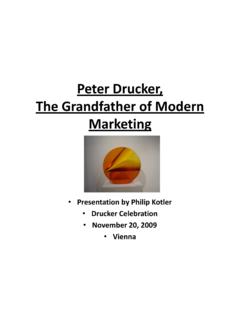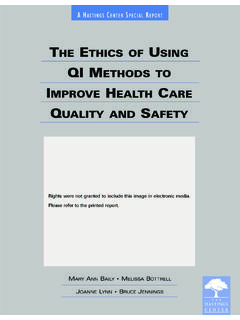Transcription of Health Promotion & Behavioural Change Theory
1 Health Promotion & Behavioural Change Theory ii CANCER SCREENING Health Promotion ENVIRONMENTAL SCAN ACKNOWLEDGEMENTS Documents prepared by: Seema M. Parmar, MHA, PhD(c), Health Promotion Associate Alberta Health Services, Health Promotion , Disease and Injury Prevention, Screening Programs, Health Promotion Rosanna Taylor, MSc. Health Promotion Research Associate Alberta Health Services, Health Promotion , Disease and Injury Prevention, Screening Programs, Health Promotion Documents reviewed by: Alberta Health Services, Health Promotion , Disease and Injury Prevention, Screening Programs, Health Promotion Alison Nelson, Manager Monica Schwann, Acting Manager Charlene Mo, Health Promotion Coordinator Melissa Hyman, Health Promotion Coordinator Carmen Webber, Health Promotion Coordinator, Screen Test Alberta Health Services, Health Promotion , Disease and Injury Prevention, Screening Programs Dr.
2 Huiming Yang, Director, Screening Programs Dr. Laura McDougall, Medical Lead, Screening Programs Krista Russell, Manager, ABCSP/ACCSP MaryAnne Zupancic, Manager, ACRCSP Brenda Lynch, Manager, Client Program Services Germaeline van der Lee, Project Coordinator, ACRCSP Maria Linehan, Project Coordinator, ABCSP/ACCSP Tammy Burke, Program Assistant, ABCSP/ACCSP Carolyn Dudley, Program Manager, EPICS, ABCSP/ACCSP Dr. Lorraine Shack, Research Leader, Public Health Innovation and Decision Support Acknowledgements: The authors gratefully acknowledge the following individuals and organizations for their contribution to the development of various elements of each of the environmental scan documents.
3 Alberta Health Services, Health Promotion , Disease and Injury Prevention, Screening Programs, Health Promotion (Alison Nelson, Monica Schwann, Charlene Mo, Melissa Hyman, Carmen Webber, Amy Williams, Teresa Earl) Alberta Health Services, Health Promotion , Disease and Injury Prevention, Screening Programs, Screening Programs (Dr. Huiming Yang, Dr. Laura McDougall, Krista Russell, MaryAnne Zupancic, Song Gao, Patricia Pelton) Alberta Health Services (Dr. Lisa Petermann, Dr. Lorraine Shack, Graham Petz, Brianne Lewis, Robyn Sachs, Jennifer Doole, Vicky Vu) Helix Designs (James Shrimpton) Palomino (Lucas Bombardier, Christina Almeida) iii Suggested Citation: Alberta Health Services (2010).
4 Health Promotion and Behavior Change Theory . Calgary, Alberta: Alberta Health Services. This document is current as of December 30, 2010. For a PDF version of this document, and more information on the environmental scan, please visit Health Promotion and Behavior Change Theory 1 Health Promotion & Behavioural Change Theory A. Introduction .. 2 B. Diffusion of Innovations Model .. 3 C. The Health Belief Model .. 5 D. The Theory of Planned Behaviour .. 7 E. The Stages of Change (Transtheoretical) Model .. 8 F. References .. 11 Health Promotion and Behavior Change Theory 2 Introduction A theoretical foundation clarifies how Health Promotion is conceptualized, encourages sharing of concepts and language between researchers and practitioners, and provides hypotheses about determinants of behaviour Change that can be Theoretical frameworks can increase the effectiveness of cancer screening Promotion interventions by defining an intervention s target population, who should be involved in delivering the intervention, expected outcomes of the intervention.
5 Factors that influence these outcomes, and strategies that can be used to improve these The choice of an appropriate framework for an intervention depends on a number of characteristics about the behaviour, target population, and environment. The Theory or framework used to inform an intervention should be logical, consistent with everyday observations, similar to models/theories used in other successful programs, and supported by past research in the same or related areas. 2 The Alberta Health Services (AHS) Screening Programs Health Promotion Unit (SP-HPU) uses various Health Promotion theories and frameworks to guide cancer screening Health Promotion activities.
6 For example, the Cancer Screening Health Promotion (CSHP) Model was created to guide the Cancer Screening Health Promotion Environmental Scan. The CSHP Model is based on the Ottawa Charter for Health Promotion , the Population Health Promotion Model, and the PRECEDE-PROCEED Model. The CSHP Model, the Ottawa Charter for Health Promotion , the Population Health Promotion Model is described in the document titled Cancer Screening Health Promotion Model on As well, the Cancer Screening Health Promotion Environmental Scan Framework is based on the Community-As-Partner Model, the Community Health Promotion Model, and the Strengthening Community Action Framework.
7 These three models and the Cancer Screening Health Promotion Environmental Scan Framework are described in the document titled Framework for the Cancer Screening Health Promotion Environmental Scan on In this document, we provide brief introductions to other Health Promotion frameworks used by the AHS SP-HPU. The models described in this document fall under the category of Behaviour Change models. Behaviour Change models examine factors that facilitate or hinder the adoption of new behaviours such as cancer screening. In this section, the Diffusion of Innovations model is described since it is often used to inform social marketing activities, which is one of the SP-HPU s strategic activities.
8 As well, this section includes descriptions of three individual-level behaviour Change models: The Health Belief Model, the Theory of Planned Behaviour, and the Stages of Change (Transtheoretical) Model. These are three of the models mentioned most frequently in the peer-reviewed literature as a basis of behaviour Change interventions. These models may be of use to others in the process of designing, implementing, and/or evaluation cancer screening Health Promotion activities. References are provided for those interested in learning more about these models. Glanz and Rimer s document titled Theory at a Glance: A guide for Health Promotion practice , published by the National Cancer Institute in the United States may be of particular interest to those who want to learn more about Health Promotion Theory and practice (available at ).
9 Health Promotion and Behavior Change Theory 3 Diffusion of Innovations Model The Diffusion of Innovations Model was first introduced in 1962 by Everett Rogers. The model is not specific to Health innovations but pertains to all innovations. Rogers defines diffusion as "the process by which an innovation is communicated through certain channels over time among the members of a social system".4 Using a bell curve distribution, Rogers describes different segments of the general population by their likelihood of adopting an innovation (Figure 1). Table 1 defines each of the groups. Rogers also describes the stages in the adoption process for individuals (Table 2) as well as the characteristics of an innovation that determine how quickly it is adopted by society (Table 3).
10 Figure 1: Distribution of Adopter Categories in the Diffusion of Innovation Theory4 Health Promotion and Behavior Change Theory 4 Table 1: Categories of Adopters in the Diffusion of Innovations Theory4 Category Definition Examples of characteristics Innovators First individuals to adopt an innovation Risk takers, younger, financially and socially stable, interact with other innovators Early Adopters Second fastest individuals to adopt an innovation High media-users, vast knowledge in specific areas, opinion is respected by others, young, educated, financially and socially stable Early Majority Slower to adopt an innovation than innovators and early adopters Above average social status, contact with early adopters, media-users.






